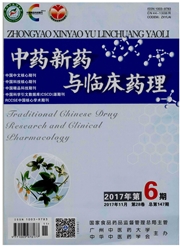

 中文摘要:
中文摘要:
目的通过观测额尔敦-乌日勒对家兔动脉粥样硬化(atherosclerosis,AS)易损斑块模型血管内皮凝血纤溶物质纤维酶原激活物(t-PA)、纤维酶原激活物抑制物-1(PAI-1)、纤维蛋白原(Fbg)的影响,探讨其稳定斑块的作用机制。方法随机将50只家兔分为正常组10只,造模组40只,利用复合因素建立家兔AS易损斑块模型,并随机分为模型组,额尔敦-乌日勒组和辛伐他汀组,分别给予额尔敦-乌日勒(0.4 g·kg-1·d-1)和辛伐他汀(5 mg·kg-1·d-1)进行干预。24周后取材,运用ELISA和免疫组化方法检测各组家兔动脉粥样硬化易损斑块模型血清及主动脉t-PA、PAI、Fbg的含量及表达情况。结果与模型组比较,额尔敦-乌日勒组家兔血清PAI-1及Fbg水平显著降低(P〈0.01),但对t-PA的影响差异无统计学意义(P〉0.05);家兔主动脉内膜免疫组化结果显示,与模型组比较,额尔敦-乌日勒组主动脉PAI-1的表达显著降低(P〈0.01),且表达量低于辛伐他汀组(P〈0.05)。结论额尔敦-乌日勒可能通过降低血清血管内皮凝血纤溶物质PAI-1、Fbg水平和增加主动脉组织t-PA的表达PAI来发挥抗AS和稳定易损斑块的作用。
 英文摘要:
英文摘要:
Objective To explore the effects of Mongolian medicine Eerdun-wurilei on the fibrinolytic biomarker in plasminogen activator (t-PA), plasminogen activator inhibitor 1 (PAI-1) and fibrinogen (Fbg) in atherosclerosis (AS) rabbit model with vulnerable plaque, and to explore its possible mechanism in stabilizing the vulnerable plaques. Methods Fifty New Zealand rabbits were evenly divided into 4 groups, normal group, model group, Eerdun-wurilei group ( 0.4 g . kg-1 . d-1 ) and simvastatin group (5 mg . kg-1. d-1). AS rabbit model with vulnerable plaque was established by balloon-induced abdominal aortic wall injury combined with feeding high cholesterol diet for 8 weeks. Twenty-four weeks later, the rabbits were sacrificed for the detection of serum levels of t-PA, PAl, Fbg as well as their expression in rat aorta by means of enzyme-linked immunosorbent assay (ELISA). Results Compared with the model group, serum levels of PAI-1 and Fbg in Eerdun-wurilei group were significantly reduced (P 〈 0.01 ), but the impact of Eerdun-wurilei on t-PA was not obvious(P 〉 0.05). Rabbit aortic immunohistochemistry results showed that PAI-1 expression in the Eerdun-wurilei group was reduced as compared with the model group(P 〈 0.01), and thePAI-1 expression level was less than the simvastatin group (P 〈 0.05). Conclusion Eerdun-wurilei plays a role in counteracting AS and stabilizing vulnerable plaques, and the possible mechanism may be related to reducing the level of endothelial fibrinolytic biomarkers PAI-1 and Fbg.
 同期刊论文项目
同期刊论文项目
 同项目期刊论文
同项目期刊论文
 期刊信息
期刊信息
